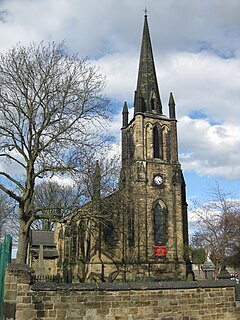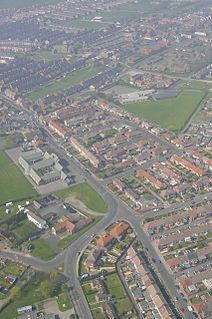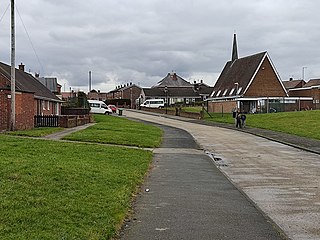
Sunderland is a port city in Northern England. It is the City of Sunderland's administrative centre, within the Metropolitan county of Tyne and Wear, the Historic County of Durham, and the North East Combined Authority area. The city is 10 miles (16 km) from Newcastle-upon-Tyne and is on the River Wear's mouth to the North Sea, the river also flows through Durham city roughly 12 miles (19 km) south-west of the city's centre.

Beamish Museum is the first regional open-air museum, in England, located at Beamish, near the town of Stanley, in County Durham, England. Beamish pioneered the concept of a living museum. By displaying duplicates or replaceable items, it was also an early example of the now commonplace practice of museums allowing visitors to touch objects.
Following is a list of dates in the history of Sunderland, the ancient city in North East England. Facts and figures, important dates in Sunderland's history.
Hetton-le-Hole is a town situated in the City of Sunderland, Tyne and Wear, England. It is in the historic county of Durham. A182 runs through the town, between Houghton-le-Spring and Easington Lane, off the A690 and close to the A1(M).

Elsecar is a village in the Metropolitan Borough of Barnsley in South Yorkshire, England. It is near the villages of Jump and Wentworth and 1.5 miles (2.4 km) south of the town of Hoyland, 6 miles (9.7 km) south of Barnsley and 8 miles (13 km) north-east of Sheffield. Elsecar falls within the Barnsley MBC Ward of Hoyland Milton. Like many villages in the area, it was for many years a colliery village until the widespread pit closures during the 1980s.
Ryhope is a coastal village along the southern boundary of the City of Sunderland, in Tyne and Wear, North East England. With a population of approximately 14,000, measured at 10.484 in the 2011 census, Ryhope is 2.9 miles to the centre of Sunderland, 2.8 miles to the centre of Seaham, and 1.2 miles from the main A19.

Horden is a village and electoral ward in County Durham, England. It is situated on the North Sea coast, to the east of Peterlee, approximately 12 miles south of Sunderland. Horden was a mining village until the closure of the Horden Colliery in 1987. Main features include the Welfare and Memorial Parks and St Mary's church. It is connected to the villages of Blackhall Colliery and Blackhall Rocks to its south by a spectacular rail viaduct which spans Castle Eden Dene near Denemouth. Horden Dene provides Horden's northern boundary with Easington Colliery.

Doxford Park is a suburb of Sunderland, Tyne and Wear, located to the south-west of the city centre. Once part of the historical township of Silksworth in the Middle Ages, Doxford Park consisted of agrarian land and a manor before being constructed into a modern housing estate in the 1960s. Surrounded by the A19, the suburb now houses one of the city's largest business districts, the Doxford International Business Park.

Monkwearmouth is an area of Sunderland, Tyne and Wear in North East England. Monkwearmouth is located at the north side of the mouth of the River Wear. It was one of the three original settlements on the banks of the River Wear along with Bishopwearmouth and Sunderland, the area now known as the East End. It includes the area around St. Peter's Church, founded in 674 as part of Monkwearmouth-Jarrow Abbey, and was once the main centre of Wearside shipbuilding and coalmining in the town. It is now host to a campus of the University of Sunderland and the National Glass Centre. It is served by the three Church of England churches of the Parish of Monkwearmouth. The first nineteenth-century Catholic church built in Monkwearmouth was St Benet's Church which remains active today.

Farringdon is a suburb of Sunderland, Tyne and Wear, England. Originally a Monastic grange and manor estate for hundreds of years, Farringdon was rebuilt as a post-war council housing estate in the 1950s. It is approximately 3 mi (4.8 km) south of the city centre along the A690, close to Thorney Close, Silksworth, East Herrington, Gilley Law and Doxford Park. Electorally, the area comes under the St. Chad's ward of the City.

Herrington is an area in the south of Sunderland, lying within historic County Durham in North East England.
Farringdon Community Academy is a co-educational secondary school with academy status, located in the suburb of Farringdon in Sunderland, Tyne and Wear, England.

Thorney Close is a suburb of Sunderland, Tyne and Wear in England.
Tunstall is a suburb of Sunderland, Tyne and Wear, England which is mostly a privately purchased estate. It is located to the west of Ryhope, and east of Silksworth. The area was built around a large hill, known as Tunstall Hill. Since 1966 pilgrims have erected crucifixes on the hill every Good Friday.

Doxford House is an 18th-century mansion in the Silksworth area of Sunderland, Tyne and Wear, England. It is a Grade II* listed building.

Bishopwearmouth Cemetery is a cemetery in Sunderland, Tyne and Wear, England. It lies between Hylton Road and Chester Road.

Chell is a suburb of the city of Stoke-on-Trent in Staffordshire, England, that can be subdivided into Little Chell, Great Chell and Chell Heath. It lies on the northern edge of the city, approximately 1-mile (1.6 km) from Tunstall, 2 miles (3.2 km) from Burslem and 3 miles (4.8 km) from the county border with Cheshire. Chell borders Pitts Hill to the west, Tunstall to the south west, Stanfield and Bradeley to the south, with the outlying villages of Packmoor and Brindley Ford to the north and Ball Green to the east. Since 2011 the area has been divided into the electoral wards of Bradeley & Chell Heath, Great Chell & Packmoor and Little Chell & Stanfield.

Hendon Burn is a stream flowing through Sunderland, Tyne and Wear. serving as a drainage basin for most of the city's southern half, its route proceeds from Doxford Park through the Farringdon Country Park area and into Gilley Law, Silksworth, Barnes, Ashbrooke and Backhouse Park before reaching the sea at Hendon.














